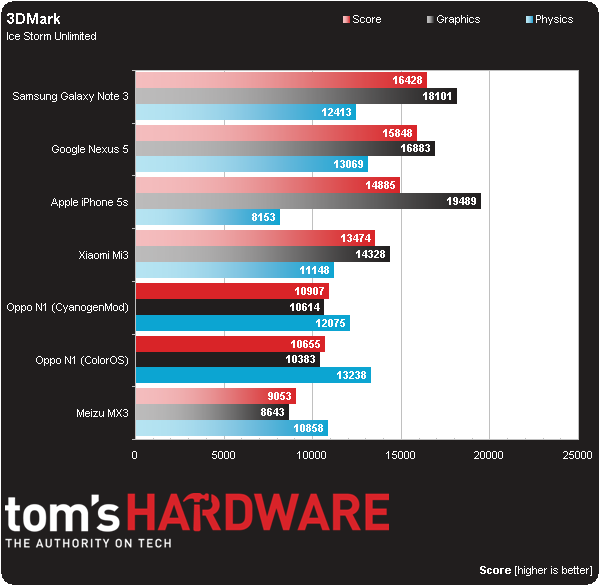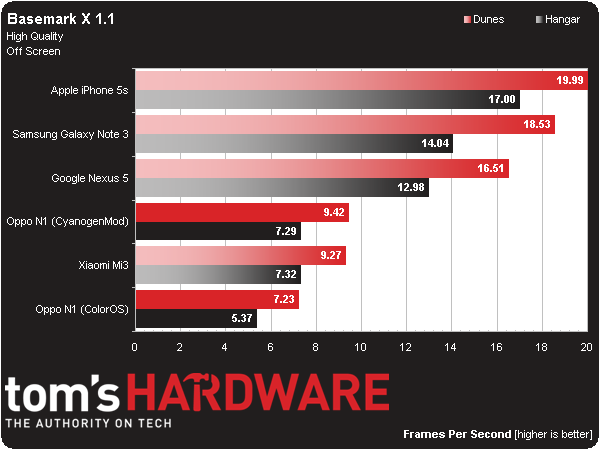Oppo N1 Review: Future-Looking Phablet Or Oversized Flop?
Oppo's N1 sports a unique pivoting camera, a large-format display, and two different operating system options. Are those features enough to make up for an older hardware platform and dicey software optimization in a sea of compelling competition?
Why you can trust Tom's Hardware
Results: GPU Core Benchmarks
3DMark Ice Storm Unlimited
Futuremark has become a name synonymous with benchmarking, and the company’s latest iteration of 3DMark offers three main graphical benchmarks: Ice Storm, Cloud Gate, and Fire Strike. Currently, the DirectX 9-level Ice Storm tests are cross-platform for Windows, Windows RT, Android, and iOS.
Ice Storm simulates the demands of OpenGL ES 2.0 games using shaders, particles, and physics via the company’s in-house engine. While it was just released in May of last year, the on-screen portions of Ice Storm have already been outpaced by more recent mobile chipsets, with Nvidia’s Tegra 4 and Qualcomm’s Snapdragon 800 both easily maxing out the Extreme version (1080p with high-quality textures). However, Ice Storm Unlimited, which renders the scene off-screen at 720p, is still a good gauge of GPU-to-GPU performance.
The two Snapdragon 800 devices demonstrate the best overall scores, with the iPhone 5s trailing close behind. The N1 sits between Xiaomi's Mi3 and Meizu's MX3, which posts the lowest score.
Looking more closely reveals a battle between the latest generation GPUs in the Graphics test: the Adreno 330 in the Note3/Nexus 5 and the PowerVR G6430 in the iPhone 5s. Nvidia’s GeForce ULP GPU in the Tegra 4-powered Xiaomi Mi3 outperforms the Adreno 320 in Oppo’s N1, while the older PowerVR SGX544 MP3 GPU in the Meizu MX3 finds it difficult to compete with the newer silicon.
In the Graphics test, the Adreno 330 is 1.71 times faster than the N1's 320 due to its clock speed (450 MHz versus 400 MHz) and ALU (32 versus 24) advantage.
The Physics test performs threaded physics simulations on the CPU. Like the other multi-core CPU tests, the iPhone 5s, with its dual-core A7 processor, is at a disadvantage and posts the lowest result. As expected, the quad-core SoCs perform well and are ordered mainly by clock frequency.
Basemark X 1.1
Based on the Unity 4.0 game engine, Rightware’s Basemark X is a cross-platform graphics benchmark for Android, iOS, and Windows Phone. This test utilizes Unity’s modern features via the OpenGL ES 2.0 render path. Features like high poly count models, shaders with normal maps, complex LoD algorithms, and extensive per-pixel lighting (including directional and point light), along with a comprehensive set of post process, particle systems, and physics effects, test how a modern game might look and run. Basemark X is an aggressive test that still hasn’t been maxed out by the latest mobile SoCs.
Get Tom's Hardware's best news and in-depth reviews, straight to your inbox.
The iPhone 5s holds a significant advantage at the Medium Quality setting. Of course, with its 1136x640 screen resolution, it only needs to render about one-third as many pixels as the other devices running at 1920x1080. Will it be able to maintain the lead in the Off Screen test?
The Note 3 and Nexus 5 pretty much tie for second. Only able to draw about half as many frames per second, the N1 is no better than the Mi3 in Dunes, but pulls ahead by a small margin in Hangar.
The iPhone 5s extends its lead at the High Quality setting by only dropping 17.5 percent compared to the Medium Quality test. The benchmark score for both the Note 3 and Nexus 5 drops by 30 percent.
At the High Quality setting, CyanogenMod is about 35 percent faster than ColorOS running on the N1. It looks like CyanogenMod might be the better OS choice for gaming.
In the Off Screen tests, the benchmark scenes are rendered at a standard resolution, independent of the device’s native configuration. This levels the playing field, neutralizing the inherent advantage held by lower-resolution devices, and allows us to easily compare SoC performance.
The Medium Quality test shows a tight battle between Adreno 330 and PowerVR G6430 (Rogue). In Dunes, this ends in a draw. Rogue, however, takes the lead in Hangar.
The N1 and Mi3 are both about 50 percent slower than the leaders.
The iPhone 5s pulls ahead of the Note 3 and Nexus 5 when scaling up the scene quality. It appears Rogue handles the more complex lighting effects and bandwidth demands of the larger textures better than the Adreno 330.
While OS choice doesn't matter for the N1 with medium-quality textures, CyanogenMod gains a 1.3x advantage in the High Quality test.
Current page: Results: GPU Core Benchmarks
Prev Page Results: Web Benchmarks Next Page Results: GFXBench 3.0-
wavetrex Just a small comment about OLED, even if this might not be the place to write about it.Reply
Probably due to to imperfections in the transistors that control the OLED pixels, there is a very faint but perceptible in deep darkness leakage of energy toward the pixels.
Yes, doesn't compare to the obvious light bleed of any TFT display, but the OLED "off" pixels are not truly off, they have a 0.00something-small level of light which could theoretically be measured by some very sensitive equipment.
The eyes are certainly capable of seeing it... -
InvalidError Putting both flash LEDs on the same side so close to the image sensor seems like a missed opportunity to me: putting one LED close to each hinge with the camera in the middle would provide more even lighting and softer shadows.Reply
With the mostly passable image quality, that would not help the N1 much though. -
Onus Please don't put the letters "p" "h" "a" "b" "l" "e" "t" together in that order and treat it like a word.Reply
-
WyomingKnott @onusReply
First time I read the term I had the image of holding my 10" Asus pad up to my face and talking into it. I suppose it's better than a shoe; cleaner, too. -
shahbaz200 Bad GPU, doesn't works well on this device, poor performance, other than that its good device.Reply -
BlankInsanity please respect my opinion, but I don't see why phones need to go bigger. i the 90s phones used to be huge and this was a problem for mobility and so as the years went by they created smaller form factor phones. Now here we are repeating that mistake. A phone is ment to make a small footprint when hidden on it's user such as a pocket. You don't put your tablet in your pocket, I don't see why'd you make a phone out of it. this is just my opinionReply -
jankeke "please respect my opinion, but I don't see why phones need to go bigger. i the 90s phones used to be huge and this was a problem for mobility and so as the years went by they created smaller form factor phones. Now here we are repeating that mistake. A phone is ment to make a small footprint when hidden on it's user such as a pocket. You don't put your tablet in your pocket, I don't see why'd you make a phone out of it. this is just my opinion "Reply
True but people couldn't watch porn on their phones back then so it made sense to make them as small as possible. Not so now ... ^^ -
Matthew DiGiacomo No offense Tom's Hardware but why are you reviewing this phone now? It's outdated and been on the market for almost 8 months.. No one really cares about it anymore.Reply -
falchard The Camera is a smart solution meaning you won't need 2 cameras. Obviously it will need tilt support to tell it which direction is up.Reply
No removable battery is a shitty solution. Its the issue all phones face after 2 years, their batteries no longer hold a charge. -
BlankInsanity Reply13717317 said:The Camera is a smart solution meaning you won't need 2 cameras. Obviously it will need tilt support to tell it which direction is up.
No removable battery is a shitty solution. Its the issue all phones face after 2 years, their batteries no longer hold a charge.
lol that's a scam the companies do to force you to buy a new one ;)







